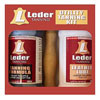
Leder tanning kits are very good. Their instructions, though, are not. This doesn’t make sense. ‘Concise’ is a bit too kind – after all, you could write them on the back of a postage stamp. The thing is, before Leder tanning kits existed, John Leidreiter was supplying every gun and saddlery store in Australia with Leidreiter Tanning Kits. He also published a very orange book titled “A Handbook on Knives, Skinning & Tanning”. With John’s book and kits, pretty well every hunter in Australia from the 1970’s to recent times has had a go at tanning their trophies at one time or other. It’s a shame John’s offerings are not available anymore. But if you squint at “Leders” it kinda sorta has a similar look to Leidreiters… anyway, back on topic… I wrote the following article (titled “Tanning Hints for Furskins”) a decade ago to fill the information void…
Use common fine salt on cool fresh skins – cover the whole flesh side of the skin to an even depth of 1mm. Roll the skin up and hang it in the shade in a jute or cotton bag (no plastic bags – the skin must be able to drain freely). 24 hours later – repeat by brushing off the old salt and replacing it with fresh salt. After 24 hours, remove the salt again, roll the skin up with it’s edges folded in to cure for 7 days – hang in the same bag in the cool shade away from direct sunlight.
Use the tanning knife to remove the flesh membrane and fatty deposits. Keep your tanning knife sharp with a flat file and flesh only on a smooth round beam – a smooth round fence post strainer works well as does large diameter PVC storm piping. Go over the whole skin removing the flesh membrane – this takes experience to do a quick neat job, but the flesh membrane is obvious on most types of skins so you’ll know when it has been removed and when it hasn’t. You’ll need to paint greasy fox skins with detergent on the flesh side and next day commence the tanning process.
Wash your skin in cool water with a little detergent. Wring out the skin until it is damp and not dripping – weigh it. A hide weighing 6kg will need a solution of 500ml of tanning chemical, 35L of water and 2kg of common fine salt (no iodized salt). Use simple proportions to calculate the amount of solution and chemicals you need to mix – a 3kg skin will need half as much solution as the 6kg one. Use rain water if possible – water laden with minerals, called ‘hard water’ is no good. Immerse the skin and wring it out several times a day – each time making sure no air bubbles are trapped under the hide and the skin is laying as flat as possible with no folds so as much solution is in contact with the skin as possible. Stir the skin and solution each time you pass your tan bath, at least do this a couple of times a day. After 24 hours, wring out the skin and inspect the flesh side of the skin. Your looking for white patches that are areas that need re-fleshing to remove flesh membrane or fatty deposits.
Tanning time depends on how thick the skin is. A 1mm thick skin will tan completely though in 3 days or so, depending on temperature. A thicker hide will take longer to tan. Nick the skin at the neck or tail (these are the thickest parts of the skin) to check an even blue shade has coloured the entire cross-section of the skin. Once you have complete penetration, tanning is complete and it’s time to wash the skin in preparation for the fat-liquoring stage.
Wash the skin in fresh water with a little soap powder. Wring out after rinsing in fresh water. Thick hides can be hung over night to reach a damp, but not wet stage. Weigh the skin in it’s damp stage and calculate the amount of Leather Lube required based on 120ml for every 1kg of damp skin. Peg the skin out with nails or a staple gun flesh side up. Pay attention to getting an even stretch and shape to the skin. A clean sheet of plywood is a good board to peg it out on. Brush the Leather Lube over the whole flesh side, with a little more lube along the thick skin areas like the tail, neck and spine. When the skins are dry they can be softened with the curved edge of the tanning knife by pushing the blade over the grain away from you over a soft pad like an old towel. Sand the flesh side with coarse grit sandpaper and trim the skin to give it an even shape and remove the hard edges.
Now look at your handiwork and make a few mental notes on how to improve your results next time.



